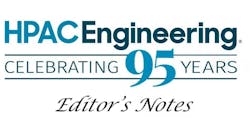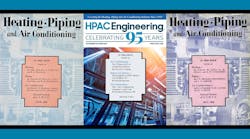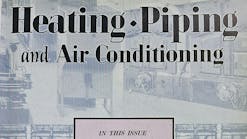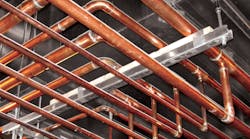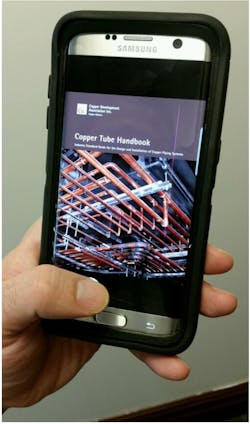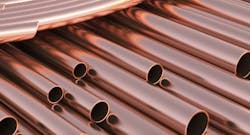By DALE L. POWELL, Copper Development Association Inc., New York NY
On a hot day, there’s nothing more refreshing than the cool breeze of an air-conditioning unit. Ironically, the units used to cool down buildings and homes can contribute to global warming. Without proper installation and maintenance, high-pressure HVAC/R applications can become leak-prone, allowing refrigerants with high Global Warming Potentials (GWP) to escape into the atmosphere. Therefore, it is critical that plumbers, contractors and technicians have a comprehensive understanding of proper installation procedures for high-pressure HVAC/R systems, including knowledge of what material is the right choice for the job.
Leak prevention is important
To curb the impact on our environment, many refrigerants previously used have been restricted and, in some cases, banned completely. Early refrigeration systems employed two common refrigerants, ammonia and carbon dioxide. Both of these refrigerants proved to be troublesome in many ways. Ammonia was extremely toxic and could cause human health concerns if a leak occurred. In 1926, chlorofluorocarbon (CFC), also called dichlorodifluoromethane (R-12) or CFC-12, was widely used, as it was considered safe for humans.
It wasn’t until a half a century later that it was discovered how damaging CFC’s are to Earth’s ozone layer. The high stability of CFCs allows chlorine to rise into the stratosphere where a single chlorine atom can destroy 100,000 ozone molecules, according to the Environmental Protection Agency (EPA).
Today’s refrigerants, such as hydrofluorocarbon (HFC)-134a, do not deplete Earth’s ozone, but its GWP is 1,430 times larger than that of carbon dioxide, according to the EPA. Refrigerants’ GWP is compared to the baseline or reference of carbon dioxide, refrigerant R-744, which has a GWP of 1. The higher the GWP number, the greater risk that refrigerant poses to global warming. While this is a stark improvement from R-12, which has a GWP of 10,900, it is clear modern refrigerants still have a massive potential impact on global warming, which is why leak-prevention is so paramount.
Ideal for high-pressure applications
Many modern HVAC/R systems are required to use refrigerants that operate at extremely high pressures and temperatures. For example, carbon dioxide operates at severely high pressures (400+ psig in cascade systems to 2,000+ psig at transcritical high-side pressures) with discharge temperatures in the 300°+ range. High-pressure applications continue to present difficult installation, maintenance challenges and leak threats, which is why copper is the correct material to use.
Copper tube and fittings have been a preferred material for high-pressure applications as far back as the late 1700s, when copper condenser tubes were used in steam engines. In 1902, Willis Carrier began working on a solution for a humidity problem that was causing magazine pages to wrinkle at a publishing company in Brooklyn NY. Carrier’s experiments led to the first modern electrical air-conditioning unit. More than 100 years later, design engineers and field technicians still depend on copper tube and fittings for strong, leak-free connections.
New innovations in copper tube manufacturing -- UNS C19400, a copper iron alloy tube and fitting -- have shown great ability in high-pressure applications. Composed of a 97 percent copper minimum, 2.1 – 2.6 percent iron and very small percentages of zinc, lead and phosphorus, UNS C19400 has proven its ability to serve as a reliable option for high-pressure systems using carbon dioxide, R-134a and other refrigerants. When UNS C19400 tube and fittings are brazed together using filler metal alloys, the combination reaches a maximum operating pressure rating of 90 Bar (1,305 psi) to 130 Bar (1885.49 psi) or more at temperatures up to 300°F. This is within the operating range of systems using R-744 (carbon dioxide), R-134, R-134a, R-410 or R-410a refrigerants.
For comparison, the copper tube ASTM B280, often referred to as ACR, has been the industry standard tube for air conditioning and refrigeration applications since the late 1940s and early 1950s. The UNS alloy C12200, composed of 99.9 percent copper and silver combined with a small percent of phosphorous ranging from 0.015 to 0.40 percent, has maximum pressure and temperature ratings of 700 psig and 250°F throughout its size range from ⅛ inch through 4 ⅛ inches per UL standard 207.
The wall of UNC 19400 is thicker than the standard ACR tube, which increases its ability to withstand high-pressure applications. The thicker wall of the copper iron tube and fitting and the shorter cup depth for the copper iron fitting can be seen in Figure 1. Both copper-iron tube and fittings have been tested and certified as meeting the requirements of Underwriters Laboratories (UL) 207 Standard for Refrigerant-Containing Components and Accessories, Nonelectrical. In designing a system, tube, fitting and joint ratings must be considered collectively, because the lower of the ratings (tube, fitting or joint) will govern the maximum installation design pressure.
Proper Installation Techniques
The shorter cup or lap length of the copper iron fitting requires that the joint be brazed and not soldered. Soldering is not permitted for copper iron alloy joints in refrigeration. Premature failure or leaks can often be directly attributed to technicians’ misunderstanding of the metallurgy and science involved in fabricating solid, reliable brazed joints. Copper-iron alloy tube and fittings can be joined using the same brazing techniques and processes utilized for standard plumbing or ACR brazing applications.
Step 1: Clean the tube and fitting
It has been proven that much stronger soldered and brazed capillary space joints are those where the tube and fitting have been mechanically cleaned (oxides removed) prior to the fabrication of either a soldered or brazed joint. The oxide melts at a temperature of 2255°F (1235°C), higher than the temperature at which the copper tube itself will melt, which is 1981°F (1083°C). So, trying to “burn off” the oxide layer won’t actually work; the tube itself will melt first.
Step 2: Apply brazing flux
It is not permitted to use soldering to join copper-iron alloy joints when used in high-pressure refrigeration applications. The American Welding Society (AWS) defines brazing as taking place above 840°F but below the melting point of the base metal. For brazed joints between tube and fittings manufactured from alloy C19400, which contain phosphorous, the use of brazing flux would not be required. However, when joining copper-iron tube to other materials that do not contain phosphorous, brazing flux is required and filler metals meeting the requirements of BAg series (brazing metals that contain 30 - 60 percent silver) brazing alloys are highly recommended.
Step 3: Heat the tube and fitting
There must be enough heat in the tube, fitting and capillary space to melt the filler metal so it flows into the capillary space. It should be understood that the alloy absorbs heat from all three of those components to cause it to melt. As it absorbs heat to melt, it is actually taking heat from them and cooling the joint to a certain extent. The telltale sign that the joint is at the temperature necessary to fabricate a satisfactory brazed joint is when the brazing filler metal (alloy) melts and flows into the capillary space. Observing the filler metal flowing and not balling up on the tube/fitting interface is a sure sign the joint is hot enough to braze.
Step 4: Cool the joint
Allow the completed joint to cool naturally. Shock cooling with water may stress or crack the joint or fitting material due to rapid contraction. Installing high-pressure systems correctly is essential to leak-prevention and can help stifle the threat modern refrigerants pose to global warming.
=================================================
The author is a project manager and piping applications specialist for CDA. He is responsible for the use of copper and copper alloy systems and products in tube and fitting applications. This article first appeared in the January 2018 print edition of HPAC Engineering magazine, pp. 28-29.
For more information on how to create leak-free connections critical to high-pressure applications, download the Copper Development Association (CDA)’s Copper Tube Handbook, available for free in the Apple or Google Play store. For more information about joining copper tube and fittings, including how-to videos on the subject, visit www.copper.org.





